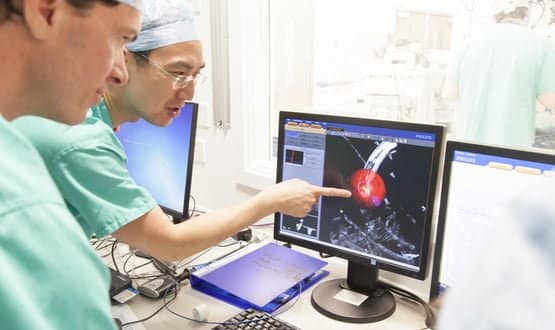New technology to lung tumours without having to puncture the skin has been used for the first time at a hospital in London.
A patient at St Bartholomew’s hospital, which is part of Barts Health NHS Trust, was the first in the world to have the procedure.
The operation involves using software to create a 3D map of the lung, which guides surgeons as they pass a catheter through the patient’s mouth and airways in order to reach the tumour.
A targeted dose of microwave energy is then administered directly to the tumour, without making a cut.
The new procedure replaces the current method, which involves puncturing the lung through the skin and muscles, which can be painful for patients.
The procedure was carried out by Kelvin Lau, consultant and lead for thoracic surgery at the trust.
He said: “This heralds a new era where more patients can potentially be cured for their lung cancer. Currently, one in five patients with potentially curable lung cancer are not fit enough to undergo the standard treatment of operation or radiotherapy, but we can now treat these patients using navigational bronchoscopy. I am absolutely delighted.”
“Navigational bronchoscopy allows us to safely and painlessly reach the tumour, without using cuts or needles, or needing to puncture the lungs.”
The superDimension navigational bronchoscopy and the Emprint microwave ablation technologies are developed and manufactured by Medtronic.
The 3D imaging software is developed and manufactured by Philips.
St Bartholomew’s Hospital is believed to be the first hospital in Europe to use the technology and was made possible by £145,000 of funding from Barts Charity.
Fiona Miller-Smith, chief executive of Barts Charity, said: “We are thrilled that the charity’s funding has been used to purchase this equipment, which is increasing the treatment options available to patients with lung cancer.
“We are proud to support ambitious and forward-thinking surgeons like Mr Lau who are pushing the boundaries of cancer treatment.”
Back in January, Digital Health News reported on how surgeons at the trust have started to use robotic technology during some procedures.


14 May 2018 @ 01:08
My mother has stage 4 lung cancer and is very fit and well. She lives in Shropshire and would want to be a candidate for this treatment would it be possible?
11 May 2018 @ 17:13
As a terminal stage 4 lung cancer patient when would this treatment be available in Queensland Australia.
My specailst is Dr.Chan Adam Crosby center Kawana University Hospital Sunshine Coast.
I would be grateful if this could be tested on myself.
Very fit 60 year-olds and currently on Tarceva 100g and morphine tablets.
Blood count was stable.
I would love to be a candidate for this treatment.
Kind regards
Simon Rawlins.
srawlins58@gmail.com